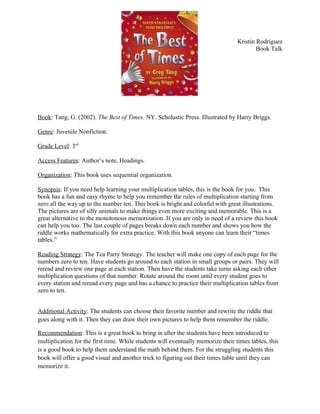
Book talk 2
- 1. Kristin Rodriguez Book Talk Book: Tang, G. (2002). The Best of Times. NY. Scholastic Press. Illustrated by Harry Briggs. Genre: Juvenile Nonfiction. Grade Level: 3rd Access Features: Author’s note, Headings. Organization: This book uses sequential organization. Synopsis: If you need help learning your multiplication tables, this is the book for you. This book has a fun and easy rhyme to help you remember the rules of multiplication starting from zero all the way up to the number ten. This book is bright and colorful with great illustrations. The pictures are of silly animals to make things even more exciting and memorable. This is a great alternative to the monotonous memorization. If you are only in need of a review this book can help you too. The last couple of pages breaks down each number and shows you how the riddle works mathematically for extra practice. With this book anyone can learn their “times tables.” Reading Strategy: The Tea Party Strategy. The teacher will make one copy of each page for the numbers zero to ten. Have students go around to each station in small groups or pairs. They will reread and review one page at each station. Then have the students take turns asking each other multiplication questions of that number. Rotate around the room until every student goes to every station and reread every page and has a chance to practice their multiplication tables from zero to ten. Additional Activity: The students can choose their favorite number and rewrite the riddle that goes along with it. Then they can draw their own pictures to help them remember the riddle. Recommendation: This is a great book to bring in after the students have been introduced to multiplication for the first time. While students will eventually memorize their times tables, this is a good book to help them understand the math behind them. For the struggling students this book will offer a good visual and another trick to figuring out their times table until they can memorize it.
- 2. Kristin Rodriguez Book Talk Book: Schwartz, D. (2003). MILLIONS TO MEASURE. NY. Harper Collins. Illustrated by Steven Kellogg Genre: Juvenile nonfiction. Grade Level: 4-6 Access Features: Sidebars, inset sections, afterword, pictures of all the items being measured are shown to help understand the size of the unit. Organization: This book is organized chronologically. Synopsis: This is a book with Marvelosissimo the Mathematical Magician. Some children want to have a race but don’t know how to decide where to race to, so they ask Marvelosissimo. The math magician takes them on a fun journey back through time to see how people long ago decided how to measure things. They learn about what people first used to measure distance, height, weight, volume, etc. The children learn about depending on the item they are measuring they may use different units of measurement. They also learn how these units relate to each other, such as kilo and kilogram. If you want to see where all the measurements that you’ve heard about came and how to use them, this is the book for you! Reading Strategy: KWL. This strategy could be done as a class or individually. Create a three- column chart. The first column should be labeled with a “K” for “Know” the second with a “W” for “Want to know” and the last with “L” for “Learned.” So first write down everything you know about measurement. List all the types of measurements that you can think of. Describe when those measurements are used. Then come up with at least three questions that you would like to know about measurements. Then once the book is read, see if any of your questions were answered. Then make a new list under the learned column of five new things about measurement that were learned. Additional Activity: Have the students go around the room and estimate to the nearest inch how tall they think any ten items are. Then have them check their estimations with a ruler. Then convert your measurement to centimeters. Be sure they create an organized chart to store all their data. Recommendation: After reading this book as a class I would spend several lessons learning all the different types of measurements. I also think including a lot of hands on measuring in the different units of measurement will be the most beneficial in getting the students to understand them all.